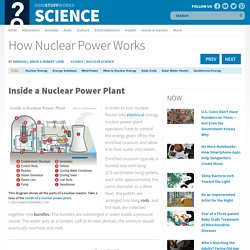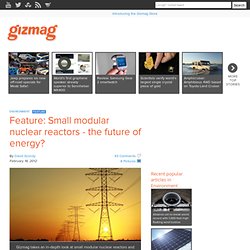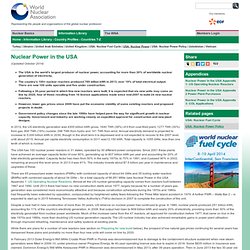

Inside a Nuclear Power Plant - HowStuffWorks. In order to turn nuclear fission into electrical energy, nuclear power plant operators have to control the energy given off by the enriched uranium and allow it to heat water into steam.

Enriched uranium typically is formed into inch-long (2.5-centimeter-long) pellets, each with approximately the same diameter as a dime. Next, the pellets are arranged into long rods, and the rods are collected together into bundles. The bundles are submerged in water inside a pressure vessel. The water acts as a coolant. Left to its own devices, the uranium would eventually overheat and melt. To prevent overheating, control rods made of a material that absorbs neutrons are inserted into the uranium bundle using a mechanism that can raise or lower them. The uranium bundle acts as an extremely high-energy source of heat. In some nuclear power plants, the steam from the reactor goes through a secondary, intermediate heat exchanger to convert another loop of water to steam, which drives the turbine. Should scientists be able to pursue their investigations regardless of potential risks? Feature: Small modular nuclear reactors - the future of energy?
This year is an historic one for nuclear power, with the first reactors winning U.S. government approval for construction since 1978.

Some have seen the green lighting of two Westinghouse AP1000 reactors to be built in Georgia as the start of a revival of nuclear power in the West, but this may be a false dawn because of the problems besetting conventional reactors. It may be that when a new boom in nuclear power comes, it won't be led by giant gigawatt installations, but by batteries of small modular reactors (SMRs) with very different principles from those of previous generations. But though a technology of great diversity and potential, many obstacles stand in its path. Gizmag takes an in-depth look at the many forms of SMRs, their advantages, and the challenges they must overcome.
View all Globally, there is a growing demand for electricity that is cheap, reliable and abundant. Not only complicated, but expensive and potentially dangerous. Then there are safety issues. Safety mPower. Nuclear Power in the USA. (Updated October 2014) The USA is the world's largest producer of nuclear power, accounting for more than 30% of worldwide nuclear generation of electricity.The country's 100+ nuclear reactors produced 789 billion kWh in 2013, over 19% of total electrical output.

There are now 100 units operable and five under construction.Following a 30-year period in which few new reactors were built, it is expected that six new units may come on line by 2020, four of those resulting from 16 licence applications made since mid-2007 to build 24 new nuclear reactors.However, lower gas prices since 2009 have put the economic viability of some existing reactors and proposed projects in doubt.Government policy changes since the late 1990s have helped pave the way for significant growth in nuclear capacity. Government and industry are working closely on expedited approval for construction and new plant designs. The USA has 100 nuclear power reactors in 31 states, operated by 30 different power companies.
Settled Science that Is 'Controversial' - Nuclear Power Is Safe. Should they publicize every discovery they make? Nuclear Energy, is it our future or our demise? Bibliography.